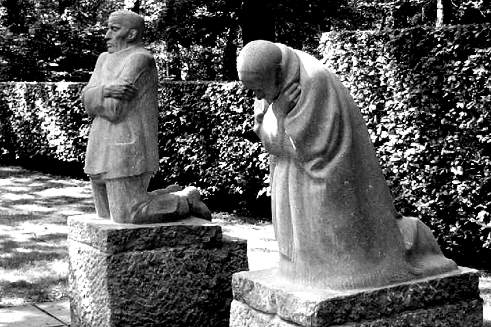The most impressive war monument I have ever seen is in Vladslo, a little Belgian village, just south of Bruges. It is made by Kathe Kollwitz, a german artist whose son died in the first world war and is buried at Vladslo. The mourning parents – father austere, mother with hands in front of her eyes – are a reminder of the real price of war.
It is always better to look at the war cemeteries of the countries that lost than to look at the countries that won the war. The American war cemeteries at the Normandy coast are glorifying the death, the Vietnam monument in Washington is mourning them. But it still is not as good as the Vladslo one.
I was reminded of this cemetery when reading the book Catastrophe, by the British former journalist Max Hastings, about the year 1914, the start of World War I.
He describes Peter Kollwitz, the son, the one who would die in the battlefields of Flanders, being 17 years old, on vacation in Norway and hurrying back to enlist in the army because this exciting war was starting. He got into a fight with his parents who said he should be happy he was too young to enlist. But Peter convinced them, somehow, we all know how silly youths can be – although I remember my dad yelling, really yelling, at me how crazy, completely crazy I was when I wanted to enlist for the first Gulf War. I had no clue about the impact of war he said; I listened to him and now am glad I did – and took a copy of Goethe’s Faust, a present of his mother.
Peter died, of course. Like millions of Germans, French, Russians and hunderdthousands of Serbians, Austrians, Brits and Americans did. In a war that could be described as a stalemate at the end. What a waste.
Hastings’ book focuses on the experiences of the people who suffered most in this war. Not the generals and secretaries of war that come up with the strategies. But about the soldiers, describing their horrible experiences in the letters they wrote home. And the citizens of the towns that were beleaguered by the different armies, and wrote about their horrors in their diaries.
It is the first book Hastings wrote about the First World War, he wrote many about WOII, but the way he approaches the different episodes of war is the same, focus on the suffering individual.
It makes great reading. Am halfway through the first book now. I would be surprised if Hastings would not write new books about the coming years of ‘La Grande Guerre’, as the french call it. The war didn’t make much progress in the years after 1914, but the story will always be lively as long as it is based on individual experiences.
The end, 1918, is clear. And then there is the peace negotiations in Versailles that, as some academics claim, were one of the causes of WWII. In a way that all human suffering through history is somehow connected. That is definitely the message of Kathe Kollwitz with her sculptures at Vladslo. If nearby, go and see them. If not nearby, make a detour.
26 jan

Share


Leave a Reply